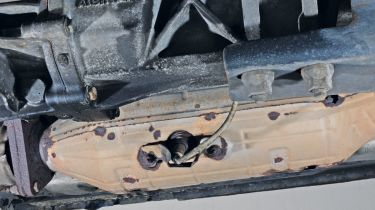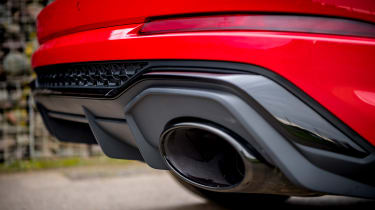Catalytic converters explained: how they work and theft prevention
Catalytic converters help clean your car’s exhaust emissions using chemical reactions with precious metals, but thefts are on the rise...

If you don’t know what a catalytic converter is, you need not lose sleep over it. The technology isn’t new and it’s present on virtually every car on the road today but there’s no real reason why catalytic converters should be at the forefront of any motorist’s mind, most of the time. They run along in the background using chemical reactions to clean harmful gasses from your car’s exhaust emissions. Unless yours breaks or, as has become increasingly common in recent years, somebody tries to steal it, there’s very little to worry about.
In this guide we explain everything you need to know about catalytic converters - from how they work to the materials and precious metals used in them - and how to protect your car from catalytic converter theft…
How do catalytic converters work?
Catalytic converters change harmful substances in a car’s exhaust gasses, such as carbon monoxide, nitric oxide, nitrogen dioxide and hydrocarbons, into less harmful substances like carbon dioxide and water vapour by means of chemical reactions.

The interior of the ‘cat’ is usually filled with a honeycomb structure onto which a coating is applied that contains a catalyst - the substance that creates a reaction with the exhaust gasses, changing their chemical structure.
Precious metals like palladium, rhodium and platinum are commonly used as the catalyst and these have an intrinsic value that means they’re worth salvaging and recycling when the car is scrapped. Unfortunately, these precious metals also make catalytic converters a target for thieves.
Catalytic converters need to work at high temperatures of up to 400 degrees to maximise their efficiency. To achieve this optimum operating temperature the first units were positioned close to the car’s engine but this caused its own issues and the cat has gradually been mover further down the exhaust system, away from the engine’s heat source.
In today’s cars the catalytic converter is found underneath the vehicle towards the exhaust outlet, a position that makes it accessible to thieves who can cut the whole unit out from underneath the car.
Types of catalytic converters
There are various types of catalytic converter. A simple ‘two-way’ oxidation cat works to turn carbon monoxide (CO) to carbon dioxide (CO2) and hydrocarbons, which are basically particles of unburnt fuel, to carbon dioxide and water. More advanced ‘three-way’ catalytic converters are fitted to modern cars and these do the above while also reducing emissions of nitric oxide (NO) and nitrogen dioxide (NO2) which together are more commonly known as NOx, a major cause of localised air pollution.
Diesel cars typically have special catalytic converters to cope with the specific emissions from compression ignition diesel engines. These Diesel Oxidation Catalyst units are routinely paired with additional exhaust treatment technologies such as exhaust gas recirculation, Diesel Particulate Filters to trap soot and Selective Catalytic Reduction which uses injections of AdBlue urea solution to remove NOx.
Catalytic converter theft
Incidences of catalytic converter thefts from cars showed a dramatic increase in 2019 with the year’s total around 10 times higher than in 2018.
Reports suggest that the growth could be attributed to supply chain issues which have made it harder for dealers to secure replacement catalytic converters through official channels, creating a black market. Historically, however, the greatest driver of thefts has been the overseas markets for the precious metals inside the units. Catalytic converters stolen in the UK are often illegally transported abroad and the metals recycled.

The cost associated with replacing a stolen catalytic converter can be as high as £2,000 - £3,000, a figure that’s inflated by the damage thieves usually do to the car when removing the unit. While thefts of catalytic converters are still rare, there are some simple steps you can take to protect your vehicle...
- Park your car in a locked garage or a well lit area in public view with the rear of the car close to a wall or fence.
- Get your car’s VIN number etched into the casing of your catalytic converter.
- Ask a local garage to weld the bolts on your catalytic converter or use other commercial anti-theft devices that will make it harder to remove.
History of the catalytic converter
Catalytic converters have been around since the 19th century when metal cylinders containing filters coated in platinum, Iridium and palladium were fitted to early French motor cars in an attempt to clean up the smoke coming out of their exhausts. The technology was first patented by Frenchman Eugene Houdry who relocated to Los Angeles in the 1930s and founded a company called Oxy-Catalyst, which fitted catalytic converters to industrial chimneys to combat smog.
• Euro 6 emissions standards and what they mean for you
Having already fitted his filters to warehouse forklift trucks, by the 1950s Houdry had begun to research catalytic converter technology for use on cars and he secured a patent for his design in 1956. The use of the technology on production cars didn’t become widespread until lead, which blocks the chemical reaction that takes place within catalytic converters, was removed from petrol and the hands of the manufacturers were forced by tightening car emissions regulations.
Today, the overwhelming majority of internal combustion engined cars on the road have a catalytic converter and there are various different kinds fitted to different models. Many cars also have supplementary systems such as exhaust gas recirculation, diesel particulate filters and AdBlue-based selective catalytic reduction technology that work with the ‘cat’ to help clean car exhaust emissions further.
Have you been a victim of catalytic converter theft? Let us know in the comments below...




